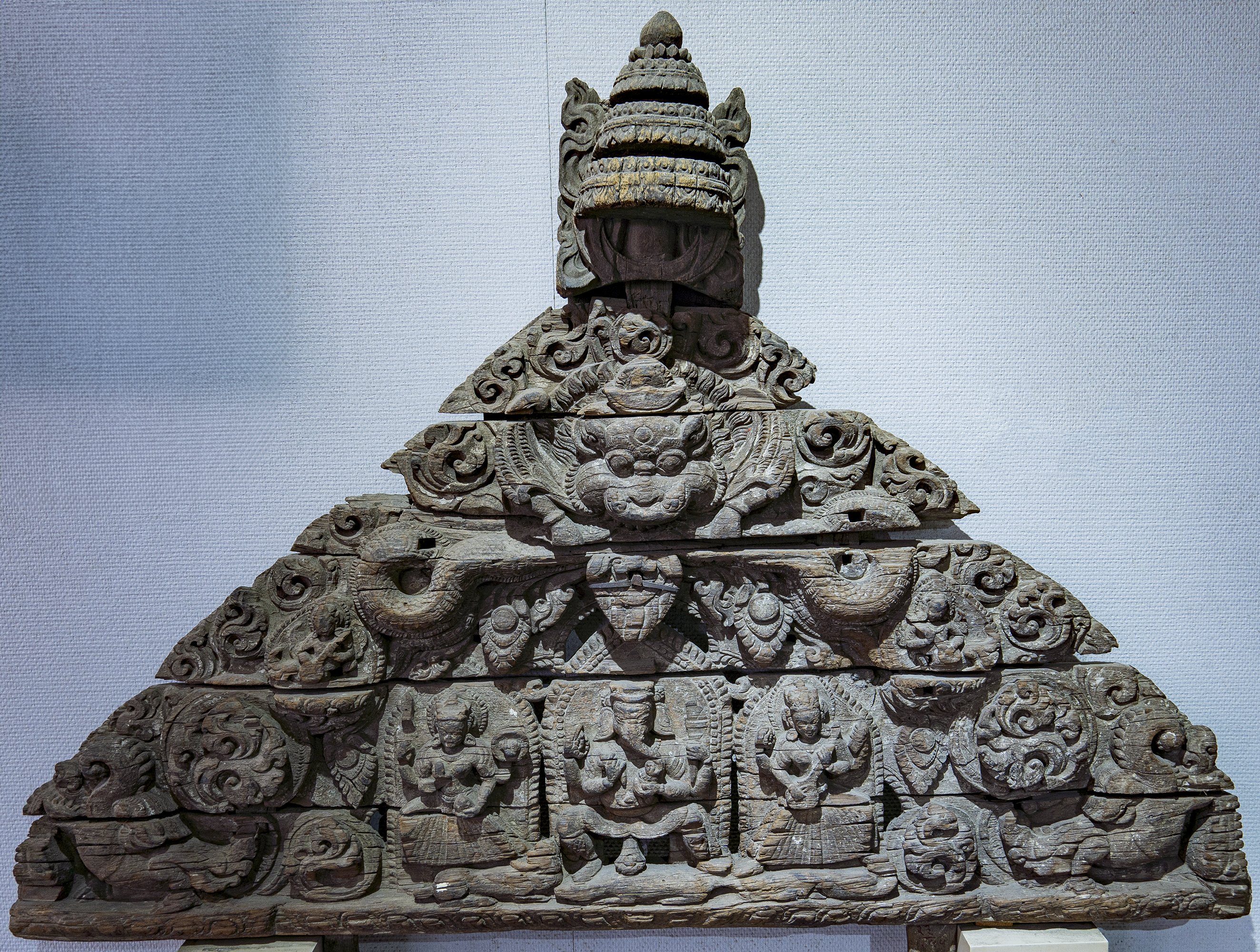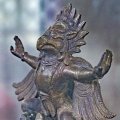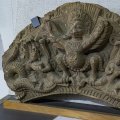Buddhist Art Gallery: Northern Himalayan Section: photo 179
Photo 179 of 198 in Gallery: Buddhist Art Gallery: Northern Himalayan Section

Image title: Torana (wooden sculpture)
Description of the photo
This Wooden sculpture shows an image of a Torana, from the 17th century.—Specifications: 96cm x 135cm x 9cm.
Transcription: तोरण, toraṇa.
Main description:
A semicircular torana is placed above the entrance of a temple in the Kathmandu Valley. It is thought to represent a style of construction transmitted from India. For instance, as is seen in the relief of the east gate of the first tower of Sanci, an arch with a sharp top was made above the entrance of a house in ancient India. It was probably originated in “the shape of gable of roof made with primitive bamboo frame covered with grass.” The arch still remains as an element of temple construction in Nepal to date.
In the top part of a torana an imaginary bird called Garuda or an imaginary animal, Kirtimukha, similar to a lion, is shown holding a snake in each claw or with its nails. In some cases the upper half of the body of the snake is in human form and the lower half descends to follow the arc of each side of the torana. At each side of lower part of a torana is carved a marine animal, Makara, gazing upward with mouth wide open. Garuda or Kīrtimukha symbolizes heaven, and the snakes held by Garuda or Kirtimukha may be considered as the mythological snake embracing the undifferentiated and primordial world at the time of the creation of the cosmos. On the other hand, Makara symbolizes the lower world, i.e. the sea and the land.
Nepalese text (not proofread):
तोरण—काठमाडौँ उपत्यकाको मन्दिर, विहार भित्र पस्ने द्वारमाथि अर्ध गोलाकार तोरण राखिएको हुन्छ । तोरणको बनावट शैली भारतबाट आएको देखिन्छ । उदाहरणको लागि भारत साँचीको पहिलो स्तम्भको पूर्वतिर रहेको स्मारकद्वारलाई लिन सकिन्छ । यहाँ एक प्राचीन भारतीय शैलीको भवनको मूलद्वारमाथि टुप्पा चुच्चो परेको अर्धवृत्ताकार वस्तु रहेको पाइएको छ । तोरणको शुरुवात छानाका बुर्जाहरूमा बाँसको फ्रेमहरू बनाई त्यसमा घाँसले छोपि बनाएका आकारहरूबाट भएको हुनसक्छ । यस्ता अर्धगोलाकार तोरणहरू अद्यापि नेपालमा मन्दिर विहारहरू बनाउँदा राख्ने चलन छ ।
तोरणको माथिल्लो भागमा एउटा काल्पनिक पंक्षि गरुड वा सिंहको अनुहार जस्तो देखिने जनावर छेपु (कीर्तिमुख) को आकृति राखिएको हुन्छ । त्यसको दुबै पञ्जा वा नङ्गाले सर्पलाई च्यापिराखेका हुन्छन् । कुनै कुनैमा सर्पको माथिल्लो शरीरको आधा भाग मानव आकृतिको हुन्छ र तल्लो आधा भाग सर्पकै रूपमा तोरणको आकार सँगै दुईतिर झरेको हुन्छ । तोरणको तल्लो भागको दुबै छेउमा मुख बाएर माथि फर्केको एक प्रकारको जलचर प्राणी मकरको मुखाकृति कुँदिएको हुन्छ । गरुड वा कीर्तिमुख स्वर्गको प्रतिक हुन् भने यसले समाइरहेको सर्प नागराज हुन् जसले संसारलाई अंगालिरहेको हुन्छ । अर्को पक्षमा मकर चाहिं मर्त्यलोक वा भवसागरको प्रतिक हो ।
English translation (automated)
Torana—A semi-circular toran is placed over the entrance to the temple, vihara of Kathmandu valley. The construction style of the pylon seems to have come from India. For example, we can take the Smarakdwar to the east of the first pillar of Bharat Sanchi. A pointed semi-circular object was found here on the main door of an ancient Indian style building. The beginning of the pylon may have been from the shapes made by making bamboo frames on the roof towers and covering them with grass. Such semi-circular pylons are still used in Nepal when building temple viharas.
At the top of the pylon there is an image of an imaginary bird Garuda or an animal lizard (Kirtimukh) with the face of a lion. Both of its claws or bare hands are holding the snake. In some cases, the upper half of the snake's body is human-shaped, and the lower half of the snake is shaped like a pylon. On both sides of the lower part of the pylon, the face of Makar, a type of aquatic creature, facing upwards with its mouth open, is carved. Garuda or Kirtimukh is a symbol of heaven, while the snake it is holding is Nagaraja, who embraces the world. On the other hand, Capricorn is the symbol of Martyaloka or Bhavasagara.
Transcription:
Toraṇa—kāṭhamāḍauṃ upatyakāko mandira, vihāra bhitra pasne dvāramāthi ardha golākāra toraṇa rākhieko huncha . Toraṇako banāvaṭa śailī bhāratabāṭa āeko dekhincha . Udāharaṇako lāgi bhārata sāṃcīko pahilo stambhako pūrvatira raheko smārakadvāralāī lina sakincha . Yahāṃ eka prācīna bhāratīya śailīko bhavanako mūladvāramāthi ṭuppā cucco pareko ardhavṛttākāra vastu raheko pāieko cha . Toraṇako śuruvāta chānākā burjāharūmā bāṃsako phremaharū banāī tyasamā ghāṃsale chopi banāekā ākāraharūbāṭa bhaeko hunasakcha . Yastā ardhagolākāra toraṇaharū adyāpi nepālamā mandira vihāraharū banāuṃdā rākhne calana cha .
toraṇako māthillo bhāgamā euṭā kālpanika paṃkṣi garuḍa vā siṃhako anuhāra jasto dekhine janāvara chepu (kīrtimukha) ko ākṛti rākhieko huncha . Tyasako dubai pañjā vā naṅgāle sarpalāī cyāpirākhekā hunchan . Kunai kunaimā sarpako māthillo śarīrako ādhā bhāga mānava ākṛtiko huncha ra tallo ādhā bhāga sarpakai rūpamā toraṇako ākāra saṃgai duītira jhareko huncha . Toraṇako tallo bhāgako dubai cheumā mukha bāera māthi pharkeko eka prakārako jalacara prāṇī makarako mukhākṛti kuṃdieko huncha . Garuḍa vā kīrtimukha svargako pratika hun bhane yasale samāiraheko sarpa nāgarāja hun jasale saṃsāralāī aṃgāliraheko huncha . Arko pakṣamā makara cāhiṃ martyaloka vā bhavasāgarako pratika ho .
Transcription:
torana—kathamadaum upatyakako mandira, vihara bhitra pasne dvaramathi ardha golakara torana rakhieko huncha . toranako banavata shaili bharatabata aeko dekhincha . udaharanako lagi bharata samciko pahilo stambhako purvatira raheko smarakadvaralai lina sakincha . yaham eka pracina bharatiya shailiko bhavanako muladvaramathi tuppa cucco pareko ardhavrittakara vastu raheko paieko cha . toranako shuruvata chanaka burjaharuma bamsako phremaharu banai tyasama ghamsale chopi banaeka akaraharubata bhaeko hunasakcha . yasta ardhagolakara toranaharu adyapi nepalama mandira viharaharu banaumda rakhne calana cha .
toranako mathillo bhagama euta kalpanika pamkshi garuda va simhako anuhara jasto dekhine janavara chepu (kirtimukha) ko akriti rakhieko huncha . tyasako dubai panja va nangale sarpalai cyapirakheka hunchan . kunai kunaima sarpako mathillo sharirako adha bhaga manava akritiko huncha ra tallo adha bhaga sarpakai rupama toranako akara samgai duitira jhareko huncha . toranako tallo bhagako dubai cheuma mukha baera mathi pharkeko eka prakarako jalacara prani makarako mukhakriti kumdieko huncha . garuda va kirtimukha svargako pratika hun bhane yasale samairaheko sarpa nagaraja hun jasale samsaralai amgaliraheko huncha . arko pakshama makara cahim martyaloka va bhavasagarako pratika ho .
Gallery information:
The Northern Himalayan region in Nepal offers a wide variety of Buddhist objects such as paintings, scriptures, sculptures, ritualistic objects, etc. Buddhism once entered Tibet from Nepal and has blended in its own way there, resulting in Tibetan Buddhism which is divided into many schools. The items found here are exhibited in the National Museum of Nepal (Rashtriya Museum).
Photo details:
Date: 2019-12-04
Camera: SONY ILCE-6400
Exposure: 1/30
Aperture: f/4.5
ISO: 100
Focal length: 18mm
High resolution:
Download file
Size: 5.41 MB
Resolution: 2647 x 2000
© Photograph by Gabe Hiemstra.
License: CC BY-NC-ND 4.0

